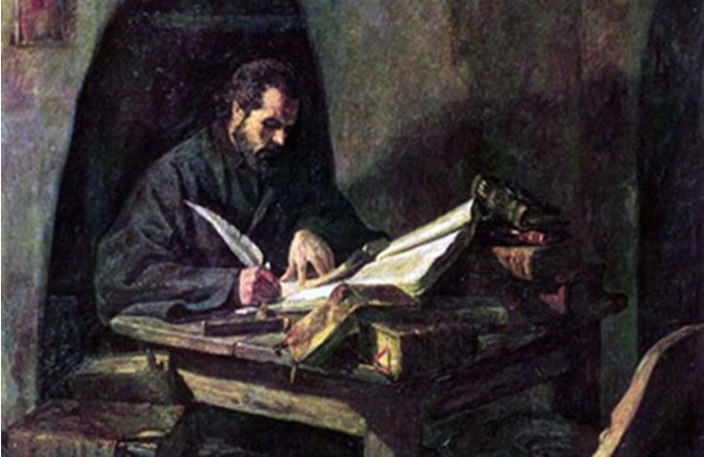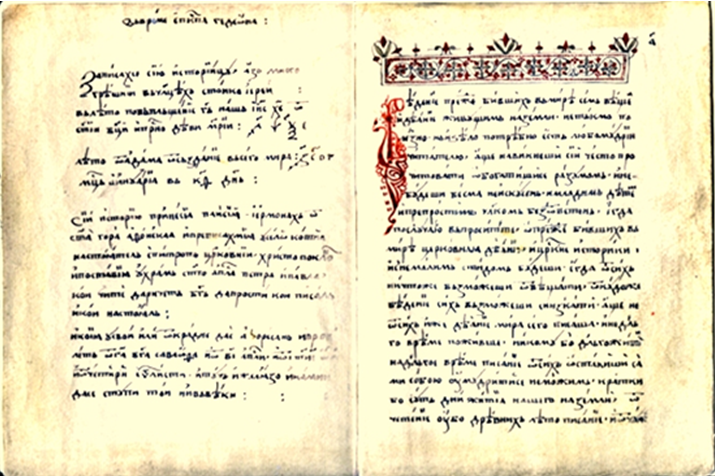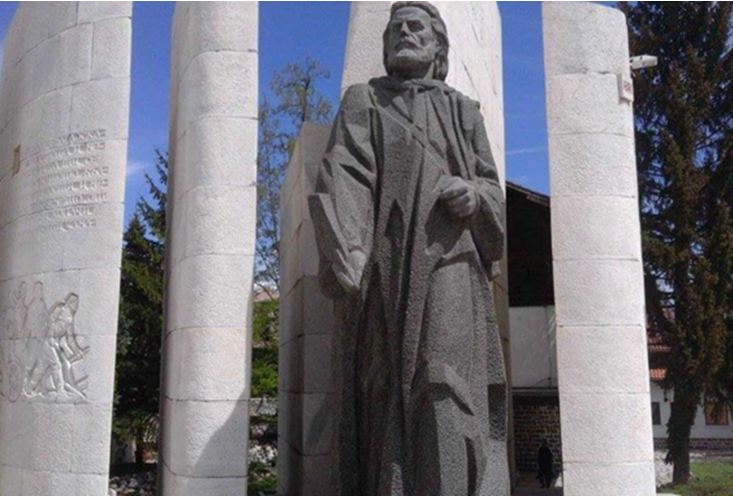Saint Paisius of Hilendar (or Saint Paisiy Hilendarski as pronounced in Bulgarian) is one of the most prominent historical figures in Bulgaria and Eastern Europe. Put in the list of Bulgarian saints and the golden pages of modern European history contributors, he is among the most influential people ever born in Bansko.
If you’re new to modern Bulgarian history, the first thing you need to know is that Paisius of Hilendar is the man who laid the foundations of the Revival period in our country. He is the man who managed to awaken the consciousness of his contemporaries and restore their confidence merely by writing a thin book called “Slavonic-Bulgarian History”.
This book managed to convey the message that Bulgarians are a people with a glorious and ancient past who gave a lot to the world. A message that was based on facts and laid the foundations of Bulgarian national consciousnesses as we know it today.
The „Slavonic-Bulgarian History” is being studied in all schools today. There is hardly anyone who is not familiar with the texts contained in it, but very little is known about the life of its author.
Below, you can learn all about the life and work of Saint Paisius of Hilendarski monastery – one of the most famous people from Bulgaria and one of the most notable personalities from Bansko.

Famous People from Bansko: Saint Paisius of Hilendar (1722 – 1773)
In „Slavonic–Bulgarian History,” Saint Paisius wrote that he was born in the Samokov district, without specifying in which settlement. But according to historians, he was born in Bansko in 1722 in the family of Mihail Hadzhivulchev.
Early Years and Arrival in the Hilendar Monastery
It is also believed that the secular name of Paisius was either Peter or Penko, and he had two brothers – Laurentius Hilendarski and Hadzhi Valcho. One of his brothers, Laurentius, was abbot at the Hilendar Monastery.
The other brother, Hadzhi Valcho, was a wealthy merchant and generous donor who donated considerable funds to construct and maintain churches and monasteries.
In the times when Paisius was born and raised, the only way to get a good education was to enroll in a monastery, as Bulgarian monks were the literal keepers of all important books and scriptures of the time.
This is probably why in 1745, the 23-year-old young man became a monk and joined his brother in the Hilendar Monastery.
The young monk trained hard during the first years behind the Hilendar monastery walls. He turned from a man who “did not know neither grammar nor secular sciences” into an educated and spiritually elevated man.
People in the monastery noticed his thirst for knowledge and willingness to work for the sanctuary and entrusted him with the difficult task of a taxidote – a monastery messenger.
Thus Paisius of Hilendar began to travel all over the country to collect aid for the monastery and to attract pilgrims.
Touring Bulgaria and Meeting its People
As Paisius toured Bulgaria, he experienced life-changing encounters. During his wanderings and meetings with the ordinary and hardworking Bulgarian families, Paisius realized that the Bulgarian people needed someone to bring back their confidence.
He saw Bulgarians falling victim to Hellenization by the greek clergy. They didn’t know their history, and some of them didn’t even speak their native language properly. Centuries of historic events were forgotten, and most Bulgarians didn’t perceive themselves worthy of self-respect.
Out of the walls of Hilendar, Saint Paisius found his true purpose. It was to show that the Bulgarian nation was formed by people with a glorious past. And over time, a desire developed in him – that the Bulgarians could rediscover that they are not a people without history.
The Mount Athos Experience
This desire became even stronger when Saint Paisiy of Hilendar went to Mount Athos, once run by mainly greek clergy, Bulgarian, and Serbian monks. There, he was surprised by the rude and arrogant behavior of the Atonic monks, who regarded the Bulgarians as “simple and clumsy people of the lower class”.
This experience heavily underlined the anti-Greek sentiments presented in the later writings of Paisius. These anti-Greek sentiments painted a picture of Greek people as Bulgarian national enemies who undermined our identity and worth. And though unpleasant to hear today, these claims were well-aligned with the zeitgeist when Bulgarians struggled to recognize their own significance.
Writing the Slav-Bulgarian History
In order to try to change things, when he returned from Mount Athos, Paisius of Hilendar began to search and gather information about the complete history of Bulgaria before the onset of Ottoman rule.
The task was not easy at all since there was almost nothing left to say about who we were and where we came from. So Paisius armed himself with great patience and started searching through our records to collect information about various historic events. He gained knowledge from monastic files, letters, stories of monks, chroniclers, donation documents, etc.
Having collected a few documents and assembled part of the historical mosaic, Paisius did not stop there. Instead, he expanded his search through monasteries in other countries.
Thus, in 1761, he reached the Sremski Karlovci Monastery in Austria, where he came across the works of Caesar Barony and Abbot MavroOrbini, from which he obtained very important information about the history of Bulgaria.
In 1761, he returned to the Hilendar Monastery and began intensive, almost night and day work on the Slavonic-Bulgarian history. Due to a misunderstanding with the other monks, he had to leave the Hilendar Monastery and move to the Zograf Monastery, where in 1762 he finished the greatest work of his life.
The Mission to Strengthen Bulgarian National Consciousnesses
Having just finished writing the Slavonic-Bulgarian history, Paisius undertook an even more difficult task. Namely – to spread the book all over the country so that more people could read it and know how proud and rebellious Bulgarian people have always been.
Thus, with a thin handwritten book about the history of Bulgaria, Paisius of Hilendar started walking on the dusty roads of the country.
He stopped in every settlement on his way. He read to the illiterate and told stories about our brave kings. He talked about fierce battles and glorious victories over huge armies. He paid special attention to the great work of the Slavic teachers Constantine-Cyril and Methodius, who gave the alphabet to all the Slavic nations.
And ultimately – he did not only write a complete history of Bulgarians through times. He helped Bulgarians know and understand it.
The Forefather of the Bulgarian National Revival
Over time, the rumor that a monk goes around villages and palanquins and tells that Bulgarians have a much more ancient history than many other peoples did spread. Moreover – it attracted the interest of people who wanted to transcribe and spread the Slavonic-Bulgarian history.
The first transcript of Paisius Hilendarski’s “History” was made by another great Bulgarian and revivalist – Sofronius Vrachanski, who Paisius met during one of his travels. After Sofronius, more than 60 Bulgarians made copies of it and transcribed Paisius’ work by hand.
Thanks to their hard work, Slavonic-Bulgarian history, written by a tireless monk, began to live its own life and became the “thing” that a whole nation needed to wake up and desire to take its place among other nations.
Paisius of Hilendar died in 1773 in the village of Ambelino on the way to Sveta Gora. Unfortunately, the cause of his death is unclear, dividing historians into two camps. One camp believes Paisius of Hilendar was attacked by robbers and killed, while the other claims he died of malnutrition and exhaustion.
Father Paisius was canonized as a saint of the Bulgarian Orthodox Church on June 26, 1962. Since then, every year on June 19, all of Bulgaria honors the memory and work of the great person born in Bansko, who managed to awake and strengthen Bulgarian spirit when Bulgarians needed it most.
Why is the „Slavonic-Bulgarian History” such an Important Book for Bulgaria?

If we had the good fortune of other European countries not to fall under the 5-century Ottoman rule, our country’s history would not be erased and forgotten, and we would remember our roots and be proud of being Bulgarians.
But unfortunately, several centuries of slavery have made our entire nation forget where it comes from and what it can do, and this has destroyed the confidence of generations of Bulgarians.
During his tours of the country, Paisius of Hilendar was confronted with people without hope who seemed to accept that they were a “second quality” nation with no history and no future.
He encountered a nation that had forgotten so much about where it came from that it readily accepted foreign language, faith, and traditions. He encountered a nation so tired and humiliated that it preferred to worship foreigners instead of fighting to keep the flames of the Bulgarian roots.
What Paisius saw heralded the end of an ancient nation, and the only way he could fix things was to try to awaken the self-esteem of Bulgarians and make them, knowing their history, believe that they were not just “slaves.” And he succeeded!
By writing the Slavonic-Bulgarian history, Paisius managed not only to bring hope to the enslaved Bulgaria.
He also managed to awaken the people’s consciousness and restore their self-confidence as Bulgarians – because they come from an ancient and great people, and they will not let any other nation punish them without consequences.
Thanks to Paisius and his small book, one of the most important historical periods began in our country – the Bulgarian Revival Period, which marked the beginning of the end of Ottoman rule. Written in simple words, “Slavonic-Bulgarian history,” even with its introduction, “hits” right in the heart…
“Oh, you unwise moron! Why are you ashamed to call yourself a Bulgarian, and why don’t you read and speak in your native language? Or did Bulgarians have no kingdom and no state? They have reigned for so many years and have been glorious and famous all over the earth…”
After this extremely influential introduction, Paisius tells the history of the establishment of the Bulgarian state, speaks about our kings, highlights our greatest victories in the battles with the Byzantine Empire, and ends with the fall of Bulgaria under Ottoman rule.
Finally, one whole chapter Paisius dedicates to the holy brothers Cyril and Methodius and their life’s work – the creation of the Slavonic alphabet.
Although this is the second modern Bulgarian history after “History of Bulgaria,” written in 1667 by Petar Bogdan Bakshev, no other book has been of such great importance in preserving our national history and memory! It turned Paisius into the most prominent Bulgarian national revival figure, as it brought along Bulgarian revival in the first place.
That is why there should not be any Bulgarian who has not read “Slavonic-Bulgarian history” and did not pay homage to its author.
Where to Pay Tribute to one of the Greatest People from Bansko and Bulgaria – Paisius of Hildendar?
Almost in the very center of Bansko, there is a monument of Father Paisius. Once you visit the town, you can spend some time putting a flower on this monument. Bulgarians must not forget for a moment that thanks to Paisius, today, we know and remember our nation’s history.

Apart from the monument, you can also visit the “Paisius of Hildendar” Spiritual and historical center, which opened its doors in Bansko in 2002.
The spiritual and historical center was built on the site of the birth house of Paisius of Hilendar. It hosts an exposition in which you can see a copy of the monastic cell in the Hilendar Monastery, in which Paisius wrote most of the Slavonic-Bulgarian history.
In addition to the copy of the cell, in the Spiritual and Historical center, you can also see the copy of the chapel “St. Ivan Rilski, “in which Paisius often prayed.
It also preserves soil from Mount Athos and many documents and pictures of the famous people who once lived in Bansko. People who left a bright trace not only in the history of Bansko but in the history of the entire country.